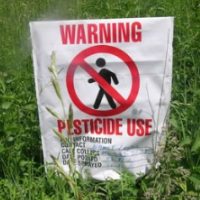State Fine-Tunes Regulation of Noxious Strawberry Pesticide

California’s strawberry crop is a $2.3-billion industry that satisfies 88% of the nation’s demand for the tasty fruit. Now, for an additional $20 million, farmers will reduce the suffering of people living and working in the vicinity of farmers who use a key pesticide to grow it.
California’s Department of Pesticide Regulation (DPR) announced new regulations this week for chloropicrin, a chemical that is injected into the ground to protect strawberries, tomatoes and almonds from pests. Strawberries account for 70% of all chloropicrin use.
The regulations are the strongest in the nation, but scientists, farmworker advocates and environmentalists say they still fall short of protecting people—especially children. Chloropicrin was the Number 1 (pdf) pesticide, measured by pounds applied within one-quarter mile of a school, in 15 key counties surveyed by a state and federal program in 2010.
“The buffers are not large enough to protect residents, workers and schoolchildren,” Anne Katten, who monitors pesticide and worker safety for the California Rural Legal Assistance Foundation, told the Los Angeles Times. “The long-term solution is to phase out the use of chloropicrin and other high-toxicity soil fumigants and move to alternative measures to control soil pests that are safer and more sustainable.”
That’s not going to happen any time soon.
Right now, they will have to settle for new rules that increase the buffer space between pesticide use and human activity and limit the acreage it can be applied to. Farmers who use tarps on their property will be subject to less stringent regulations.
Strawberries account for at least 8% of pesticides used in the state, despite occupying less than 1% of its farmland. The threat from fumigants isn’t directly to consumers; it’s to the environment and people who live and work close to the escaping gases.
State records show that 787 people suffered irritated lungs, coughing, headaches, water eyes and other symptoms from chloropicrin exposure between 2002 and 2011. The numbers are almost certainly low, considering that migrant workers and their families are not known as the most vociferous of public complainers.
Chloropicrin was used in World War I as a chemical weapon. After the war, chloropicrin reserves were repurposed as an agricultural fumigant where it was found to kill worms, fungi and other parasites as effectively as it made soldiers ill.
But over the years, other chemicals were found to be more desirable. Methyl bromide was a big hit for decades until it was linked to the atmosphere’s disappearing ozone layer. Methyl iodide has been touted as a substitute, but is a known mutagen and may cause cancer, nerve damage or fetal development problems for those in close proximity to fumigated fields.
Metam sodium, which can cause respiratory problems, and 1,3-Dichloropropene, also known as Telone and considered a known carcinogen by the state, are a couple of fumigants in the growing pesticide sector.
“Once again California is ensuring that the communities where we produce and grow food are protected from harm,” DPR Director Brian Leahy said in the release announcing the regulations.
–Ken Broder
To Learn More:
California Unveils Strictest Rules on Pesticide (by Scott Smith, Associated Press)
State Puts Limits on a Pesticide Used for Strawberries, Other Crops (by Tony Barboza, Los Angeles Times)
Is the State Going to Replace One Awful Pesticide with an Even Worse One? (by Ken Broder, AllGov California)
DPR Recommendations Leave Schoolchildren, Rural Communities at Risk from Pesticides (Californians for Pesticide Reform)
A Generation In Jeopardy: How Pesticides Are Undermining Our Children’s Health & Intelligence (Pesticide Action North America) (pdf)
Agricultural Pesticide Use Near Public Schools in California (California Environmental Health Tracking Program) (pdf)
Control Measures for Chloropicrin (California Department of Pesticide Regulation) (pdf)
- Top Stories
- Controversies
- Where is the Money Going?
- California and the Nation
- Appointments and Resignations
- Unusual News
- Latest News
- California Forbids U.S. Immigration Agents from Pretending to be Police
- California Lawmakers Urged to Strip “Self-Dealing” Tax Board of Its Duties
- Big Oil’s Grip on California
- Santa Cruz Police See Homeland Security Betrayal in Use of Gang Roundup as Cover for Immigration Raid
- Oil Companies Face Deadline to Stop Polluting California Groundwater





